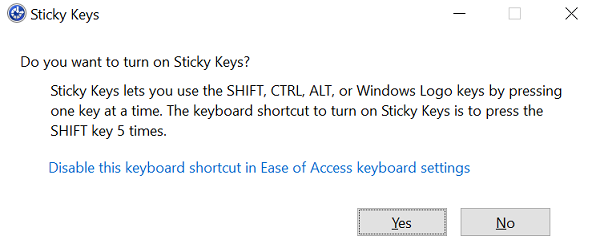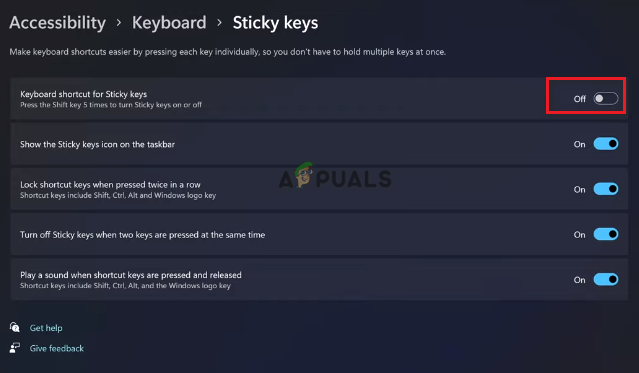How to Turn OFF Sticky Keys Popup in Windows 11/10?
Sticky Keys are a great feature in Windows that allows the use of multiple keys, such as Shift and Ctrl. You can use these keys regardless of whether you are pressing them or not. However, there are certain times when this feature can be accidentally activated by pressing the Shift key several times. This can cause a pop-up to appear on the screen, indicating that Sticky Keys have been activated. This pop-up is forced to minimize anything that’s running in the foreground, such as a game, and it can be really annoying when that happens.

If you have accidentally activated the Sticky Keys feature and are wondering how to disable it, the following guide provides easy methods to disable the Sticky Keys feature in Windows.
Workaround: Use modifier keys.
If you are constantly getting the Sticky Keys pop-ups, then as a workaround, you can use the simplest method to disable this feature. Simply press any two modifier keys, such as Ctrl, Windows, Shift, or Alt, at the same time to deactivate the sticky keys on Windows easily.
1. Disable the Sticky Key shortcut.
When you are unable to disable the sticky keys, it is possible that you do not have the shortcut turned off. Having the shortcut enabled by default prevents you from disabling this feature. Therefore, you must follow the instructions below to turn off the sticky keys shortcut for both Windows 10 and Windows 11:
For Windows 11.
- Press the Win + I keys together to open the Windows Settings.
- Navigate to Accessibilities > Keyboard.
- Click on the arrow next to the Sticky keys option.
- Turn off the toggle button for the ‘Keyboard Shortcut for Sticky Keys‘ option.
- This will disable the sticky key shortcut in Windows 11.

Turning off Keyboard shortcut for Sticky keys Windows 11
For Windows 10.
- Open the Windows Settings using the Win + I keys.
- Navigate to Ease of Access > Keyboard.
- Under “Use Sticky Keys“, turn off the toggle button.
- Uncheck the box labeled “Allow shortcut key to start Sticky Keys.
- This will disable the sticky key shortcut in Windows 10.

Turning off Keyboard shortcut for Sticky keys Windows 10
2. Disable Sticky Keys from the Control Panel.
If you are still receiving the endless cycle of Sticky Key pop-ups, you can deactivate the feature entirely from the Control Panel. To do that, you can follow the step-by-step instructions we have listed below:
- Open the Run Command by pressing the Win + R keys simultaneously.
- Type “Control Panel” and press the Enter key.

Opening the control panel - Click on the “View by” option.
- Select “Category” to view options in various categories on the page.
- Open the “East and Access” page.
- Uncheck the “Always Read This Section Aloud” box under “Quick Access to Common Tools.
- Navigate to Ease of Access Center > Make the keyboard easier to use.
- Uncheck the “Turn on Sticky Keys” box and open the “Set up Sticky keys” option.

Turning off sticky keys - Uncheck the “Turn on Sticky Keys when SHIFT is pressed five times” option under “Keyboard shortcut.

Turning off sticky key shortcut - Click Apply to save the changes.
- Uncheck the “Turn on Filter Keys” box and open the “Set up Filter keys” option.

Turning off filter keys - Uncheck the “Turn on Filter Keys when SHIFT is pressed five times” option.

Turning off filter key shortcut - Confirm the changes by pressing the Apply and OK options.





